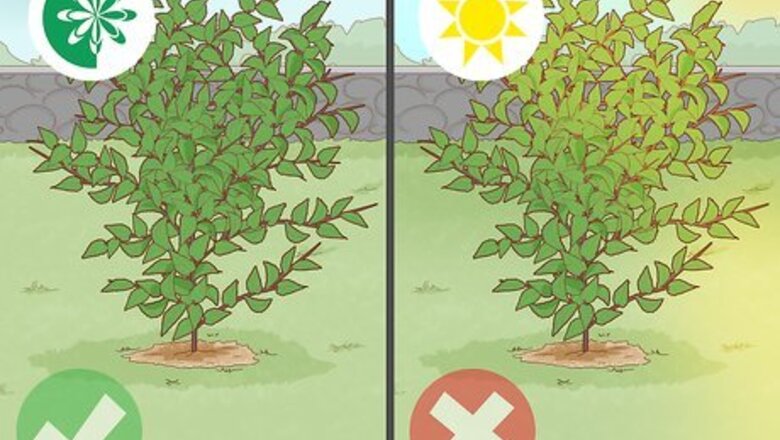
views
Exposing the Wood
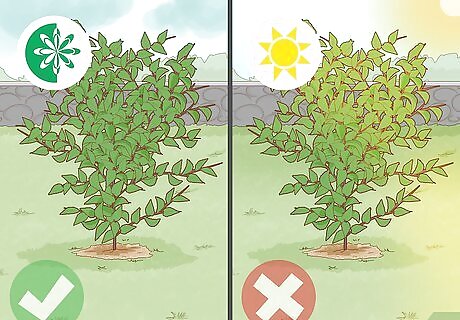
Start air layering in the spring. Air layering works best when the roots have the summer growing season to form. Wait until mid-spring when blooms just start to form on the trees. Pick a cloudy day to air layer the tree so the sun doesn’t put stress on it. You can also try air layering in the late summer months, though the roots may not grow as well if temperatures dip below freezing during the winter.
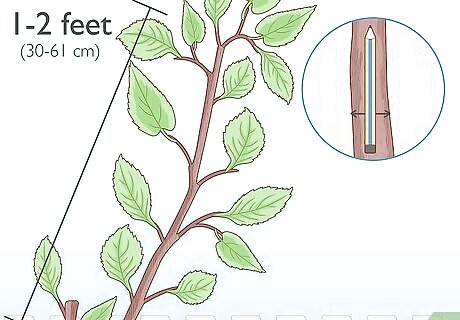
Choose a branch from last season’s growth that’s thicker than a pencil. Look for branches that point up and are at least 1–2 feet (30–61 cm) long. Try to choose branches that grew during the last year since they produce roots better than old, established ones. Make sure the branch is at least as thick as a pencil, or else it may not grow well later on. If you’re air layering in the late summer, choose growths from the current season instead. You can air layer multiple branches on the same tree.Examples of Plants to Air LayerApple treesOrange treesLemon treesAzaleaMagnoliaRubber plantBonsai trees
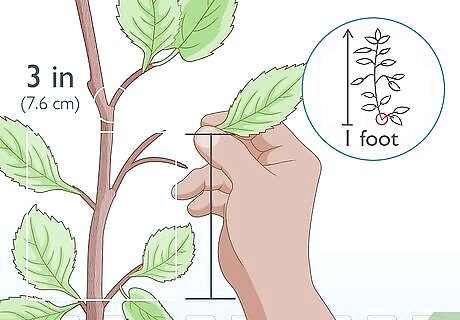
Remove the foliage and twigs 3 inches (7.6 cm) around a leaf node. Locate a point where leaves connect to the branch that’s about 1 foot (30 cm) from the end of the growth. Pull the leaves off of the branch by hand so there’s about 3 inches (7.6 cm) clear on either side of the node. If there are twigs or other branches in that area, cut them off with a gardening knife or pruning shears. Don’t remove all of the foliage from the branch or else it won’t grow as well when you remove it from the tree.
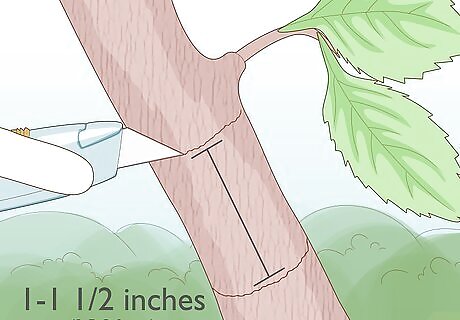
Make 2 parallel cuts through the bark so they go around the branch. Push the blade of a gardening knife into the bark just below the leaf node until you feel it make contact with solid wood. Guide the knife around the branch to cut a ring into the bark. Move the blade 1–1 ⁄2 inches (2.5–3.8 cm) lower down the branch and cut another ring around the branch’s circumference. Don’t apply too much pressure to the knife blade, or else you could cut through the branch completely.Variation: If you’re working with a slow-growing tree, such as maple, juniper, pine, or azalea, or you want to create a sturdier trunk for a bonsai tree, loop an 8-gauge copper wire around the branch underneath the node and pull it tight until it cuts into the bark. This will help the branch grow thicker before it starts making roots.
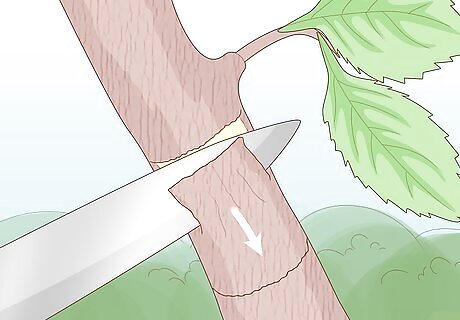
Peel the ring of bark off of the branch. Put the knife against the top cut and push the blade down toward the bottom cut to start peeling the bark off. Pinch the piece of bark by hand and slowly tear it away from the branch. Continue removing the bark from the ring until you see green or white wood underneath. You may need to make a vertical cut from the top ring to the bottom ring to help you get a better grip on the bark. If you get skin irritation from tree sap, put on gardening gloves before you peel off the bark.
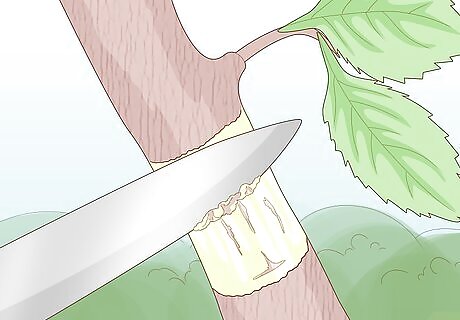
Scrape the exposed wood with the knife blade. Hold the knife so the blade is parallel against the top of the ring. Drag the blade down to the bottom of the ring to remove the protective plant layer on the wood. Scrape the wood up and down as you work your way around the branch. Rubbing the wood removes a layer of cells called cambial tissue, which would cause the bark to grow back if you left it on. Disinfect your knife blade with rubbing alcohol after cutting each branch if you plan on air layering multiple trees. That way, you prevent spreading diseases or bacteria between plants.
Growing the Roots
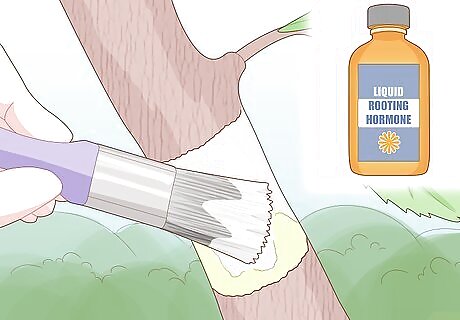
Apply a rooting hormone to the exposed wood. Get a liquid rooting hormone so it’s easier to apply to the exposed wood. Dip a paintbrush in the rooting hormone and let any excess drip off of the bristles. Spread the rooting hormone on the ring you cut around the branch to help increase the chances of roots forming. You can buy rooting hormone from your local gardening store or online. Rooting hormone isn’t required to air layer trees, but it may speed up growth.
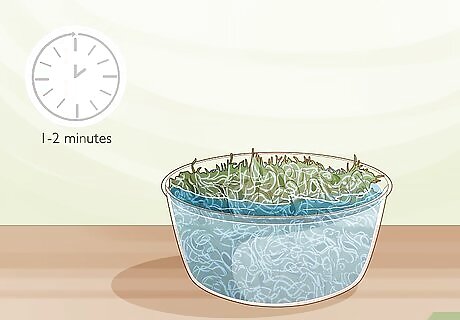
Moisten a handful of sphagnum moss in clean water. Sphagnum moss is a common rooting medium that retains moisture well. Take a large handful of the moss and soak it in a container with water for 1–2 minutes. Pull the moss out from the container and squeeze out any excess water so it isn’t dripping wet. You can buy sphagnum moss from your local gardening center. Wring out the moss as much as possible, or else the excess moisture could prevent roots from forming and cause rot.
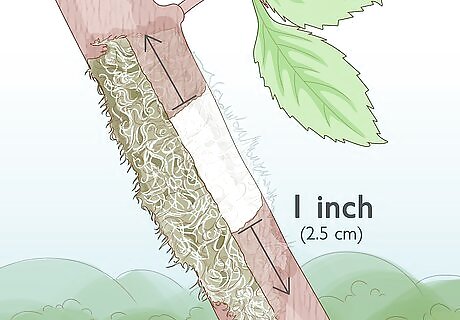
Wrap the sphagnum moss around the exposed wood. Split the ball of moss into halves and hold one in each of your hands. Press the moss onto the top and bottom of the branch so it extends 1 inch (2.5 cm) past the edges of the ring. Squeeze the moss tightly so it has firm contact with the wood and stays in place. Let go of the moss slowly to make sure it doesn’t fall off the branch. If it starts to slip, keeping holding it or ask a helper to hold it while you continue working.
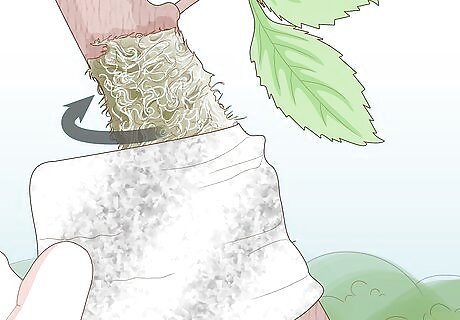
Cover the moss with a plastic wrap or aluminum foil. Rip a sheet of plastic cling wrap or aluminum foil large enough to cover the moss off from the roll. Press the wrap or foil tightly against the moss and the branch so it has firm contact. Make sure to wrap the entirety of the moss so you trap in moisture and promote healthy root growth. Plastic wrap allows you to see when roots form easier than foil, but either will work the same. If the part of the branch with the moss gets direct sunlight throughout the day, use dark-colored or opaque plastic wrap to prevent the moss from drying out.Tip: If the plastic wrap or aluminum foil doesn’t stay tight against the moss, tie the ends to the branch with twine or twist ties.

Leave the branch on the tree until the moss fills with roots. Look through the wrap or peel back the foil once per week to check for roots growing throughout the moss. If you don’t see any, leave the wrap on the branch and take care of the tree as you normally would. If you do see roots around the outside of the moss, then you can remove the air layer from the tree. Typically, it will take around 6–8 weeks for healthy roots to fill in the moss, but it may vary based on the climate and tree species. The sphagnum moss should stay moist as long as it’s wrapped tightly, but rewet it if it feels dry when you check for roots.
Transplanting the Propagation

Fill half of a pot with drainage holes with potting soil. Choose a pot that has a diameter and height at least twice the size of the roots growing on the air layer. Make sure the pot has drainage holes on the bottom so the soil doesn’t get waterlogged. Choose a potting mix meant for trees and pour it loosely into the pot. Buy potting mix from your local gardening center. You can use clay or plastic pots for your propagation.Warning: Avoid planting the propagation directly in the ground since it could stress the tree and prevent it from growing healthy.
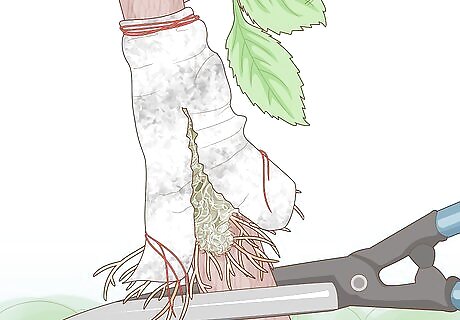
Cut the branch off just below the new roots. Hold the branch with your nondominant hand just above the moss to keep it steady. Grip the branch with a pair of pruning shears right underneath the moss and squeeze the handles together. Lift the cut branch away from the tree, being careful not to hit or damage the roots. If you have trouble cutting through the branch with pruning shears, use a tree saw instead.
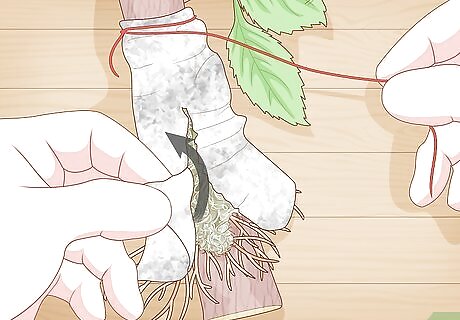
Remove the plastic wrap or foil from the roots. Poke your gardening knife carefully through the plastic wrap or foil to make a starting hole. Carefully pull the wrap apart by hand so you don’t damage any of the roots inside. Pull off as much of the wrap or foil as possible, but leave the moss around the roots so you don’t stress them. If you remove the moss from the roots, the tree may get stressed and prevent them from growing well.
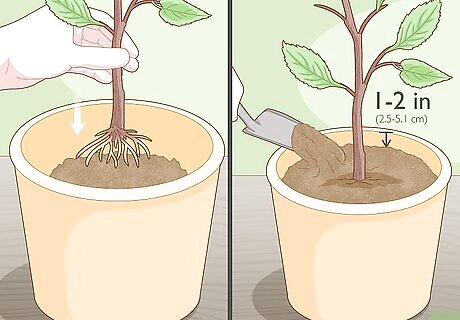
Set the roots in the soil and backfill the pot. Hold the cut branch vertically with your nondominant hand and keep it steady in the center of the pot. Use a trowel or shovel to scoop more potting mix around the moss so it’s completely covered. Continue filling the soil until there’s 1–2 inches (2.5–5.1 cm) of space between the lip of the pot and the soil’s surface. Shape the soil around the tree into a small mound to help prevent it from getting waterlogged or developing root rot.
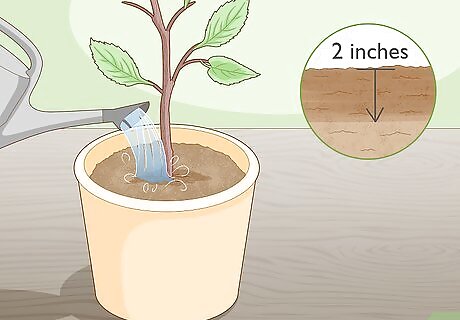
Water the soil so it’s moist 2 in (5.1 cm) below the surface. Use a watering can to wet the soil until it starts puddling on the surface. Allow the soil to absorb the water and let it drain from the holes in the bottom of the pot. Pour water in the pot until it puddles again and let it soak deeper toward the roots. Check if the soil feels wet 2 inches (5.1 cm) below the surface, and it does, stop watering. Water the tree whenever the soil feels dry 1 inch (2.5 cm) below the surface.
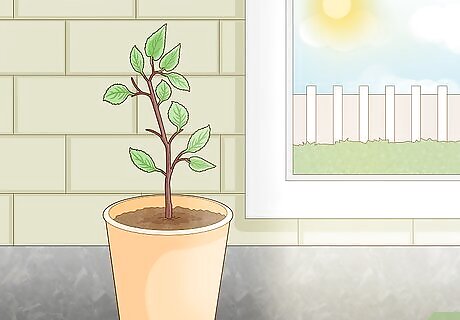
Keep the tree in a shady area out of direct sunlight. Place the tree near a north- or south-facing window so it still light without being directly in the sun. Make sure there aren’t any drafts near it since it can cause the soil to dry out or damage the tree. Keep the plant in its pot while the root system adapts to the new growing medium. If you want to keep the pot outside, make sure it doesn’t get sunlight, or else it will use most of its energy to make new leaves or blooms instead of roots.
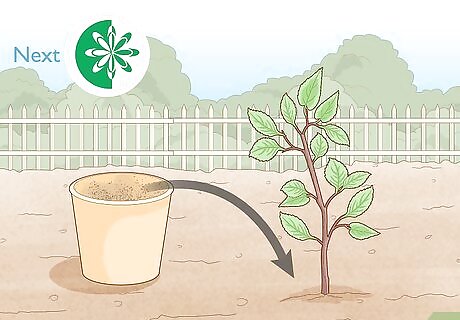
Plant the new tree in the ground during the next spring. Allow the plant’s roots to fully develop in the pot, which usually takes 4–5 months to form. When you’re ready to transplant, dig a hole in the ground that’s twice as wide and 6 inches (15 cm) deeper than the pot. Carefully pull the tree out of the pot and set it in the hole before filling it back in. Water the tree as you normally would so it doesn’t get stressed. Install a vertical post next to the tree and tie the trunk to it if you want to help it grow straight. There are several ways of propagation. You can use leaf cuttings or stem cuttings for propagation. Or use methods like a rhizome, tuber, or water propagation. The essential tools you need to propagate a plant are a pair of clippers, a sharp knife, and gloves. Besides this, you may also need some other things. For example, you need rooting powder for stem cuttings.




















Comments
0 comment